Pausha Putrada Ekadashi 2025: 30 या 31 कब है पौष पुत्रदा एकादशी व्रत? जाने सही तिथि व मुहूर्त
पौष पुत्रदा एकादशी 2025: क्या आप जानते हैं कि साल 2025 अब धीरे-धीरे हमसे विदा ले रहा है? लेकिन जाते-जाते…
 0%
0%

When we speak or mention South India, we know its cultural and regional heritage, rituals, temples, and festivals. South Indian Festivals are packed with ancient customs and are holy.
These lands are distinguished by their customs and ceremonies that have existed for centuries.
At every turn, there are stories about old sacred texts, blinking lights, and a rich atmosphere of spiritual comfort.
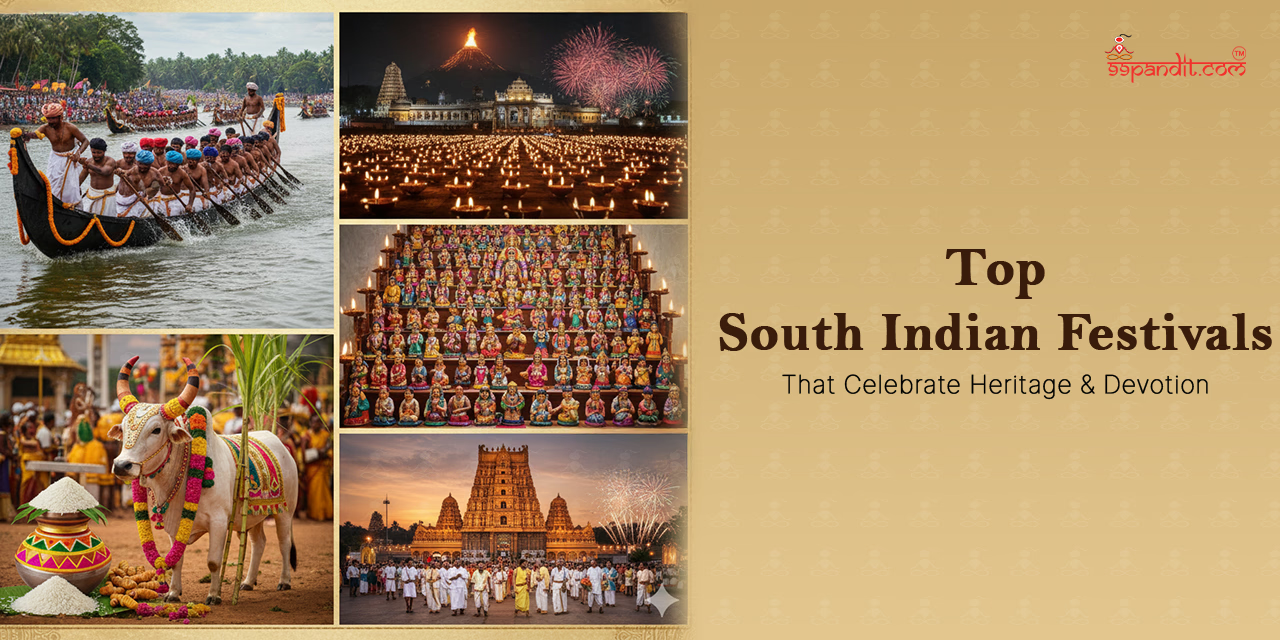
There is no limit to how much people cherish all the festivals as part of their heritage and unshakable belief.
During the South Indian festival, anyone can feel a touch of emotion, the essence of music, dance, and art.
Whether it is lightning lamps during Karthigai Deepam to welcome King Mahabali during Onam or a regular temple procession, a story of the past, piety, and union is followed during each festival.
So buckle up your seat. We are going to discover the top South Indian Festivals with 99Pandit. This blog will tell you everything about the festival and its story. So, let us get started!
Each part of South India has its charm, but do you know why it is so special? It’s lively and varied festivals!
The atmosphere of South Indian festivals is one of celebration, pleasure, and wealth found within a singular cultural backdrop that will live long in the memory.
These states, such as Kerala, Tamil Nadu, Karnataka, Telangana, etc., are called South India and represent the southernmost part of India.
Kerala is known for its white print. It is commonplace in festival celebrations throughout the year.
The festivals highlight an association for practice in each state. Each one contributes its flavour to the diversity of the southern culture.
Each of these festivals has its history and legend behind it, as well as a diverse manner in which they are celebrated. The following are the top 10 South Indian festivals:
Onam, the state festival of Kerala, is celebrated during Chingam by Malayali people. The Onam festival acknowledges the end of the harvest and the monsoon.
The festival conveys cultural lineage, intrinsic spiritual purity, and an innate association with Nature. According to legends, the Onam Festival also represents the return of King Mahabali.
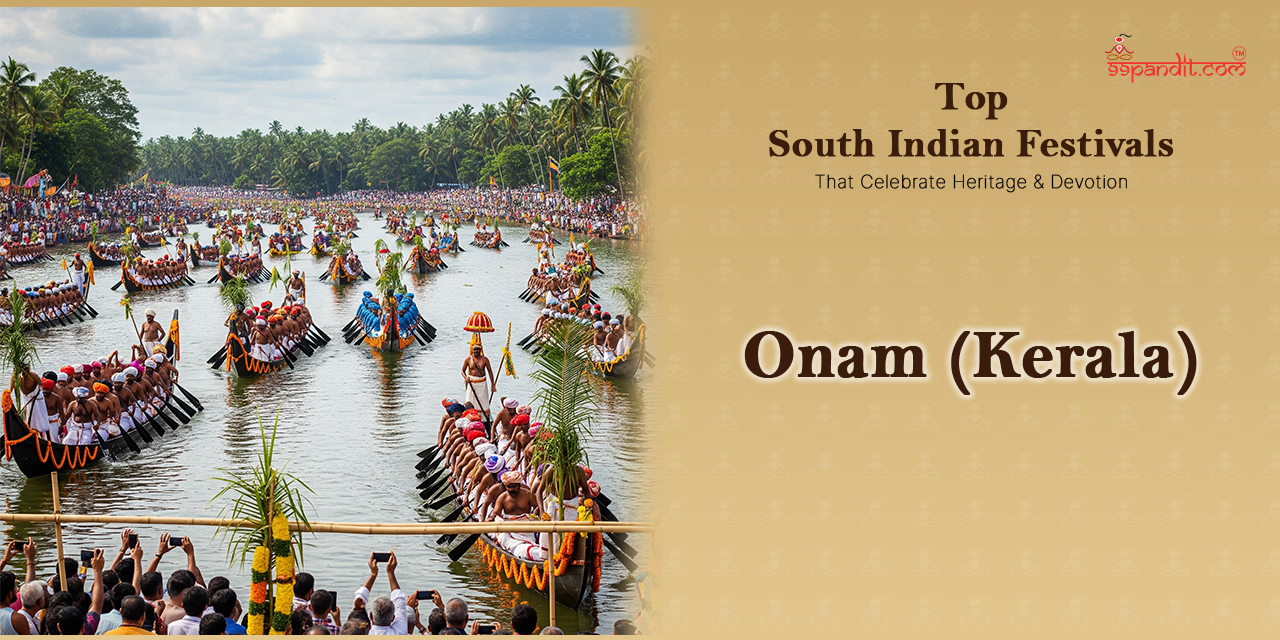
Onam is celebrated for ten days, from the star of Atham to Thiruvonam in Chingam. Avittayam and Chathayam represent the third Onam and fourth Onam, respectively.
The most auspicious day of the Onam festival is Thiruvonam, which is celebrated on the last day of the Onam festival.
According to the beliefs of the Malayalam people, Onam is the day when Lord Vishnu took the Vamana avatar.
This day is also celebrated as the return of the great king Mahabali to earth. It is believed that on the day of Thiruvonam, King Mahabali comes to earth from the underworld every year.
It is also said that King Mahabali visits every Malayali house and meets his subjects on this day.
A traditional meal of Onasadya on banana leaves is thought to be auspicious. A traditional dress is usually worn, and people greet each other with hugs.
Cultural activity and traditional competitions and games, such as boat races and cultural performances, are organized.
Pongal is a festival associated with the harvesting of new crops and prosperity. The entire South India celebrates this festival with great beauty.
This festival is celebrated in different ways for four consecutive days. Indra Dev and Surya are worshipped during this festival, and everything related to nature, like Indra, Surya, cows, and bulls, is worshipped.
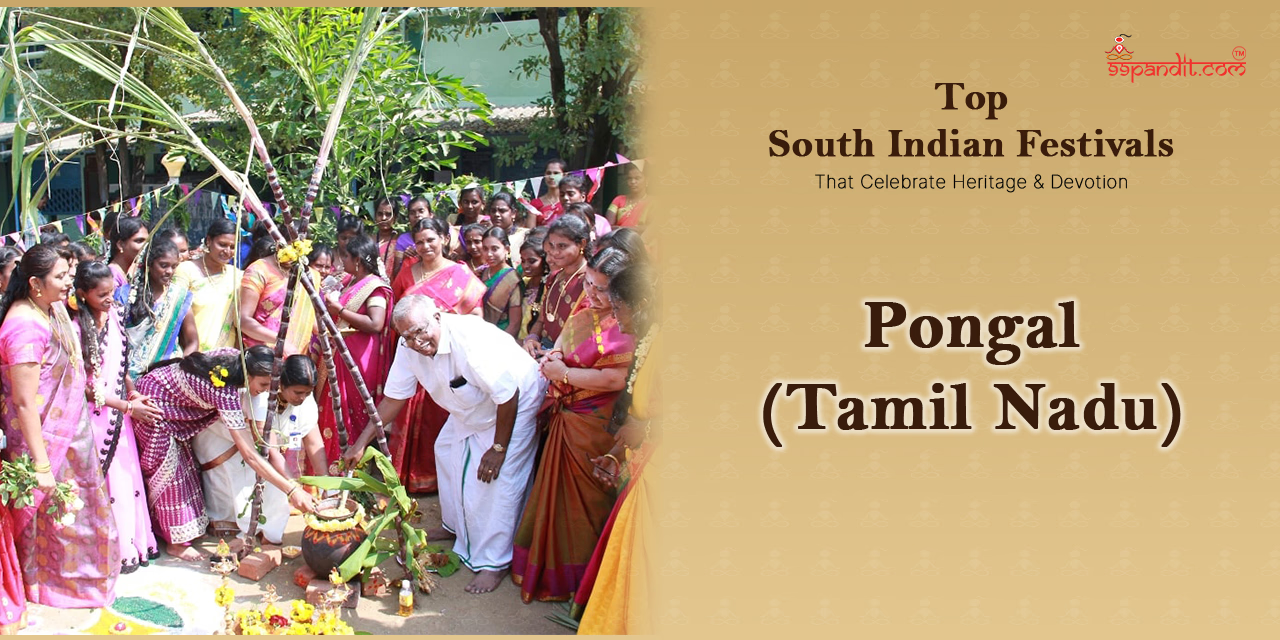
The word Pongal, in Tamil, is derived from the phrase Pongu, which means ‘boiling‘, and from this, Pongal is derived.
The festival of Pongal is of great significance to the Tamil people. It is celebrated for four days.
These days are ‘Bhogi Pongal‘, ‘Surya Pongal‘, ‘Mattu Pongal‘, and ‘Kannam Pongal‘. Different traditions and customs are followed on each day of Pongal.
This festival commences on the first day of the month of ‘Thai’ in the Tamil calendar. The Pongal festival contains prayers for Indra Dev and Surya.
The festival is all about plenty. In Pongal, prayers for profit and welfare worship the rain, the Sun, and agriculture-related aspects.
The Mysore Dasara is a popular Hindu festival in Karnataka, India. It happens once a year as an emblem of the triumph of good over evil.
Mysore Dasara is also known as Nadahabba or Nada Habba. It is recognized as a state festival in Karnataka.
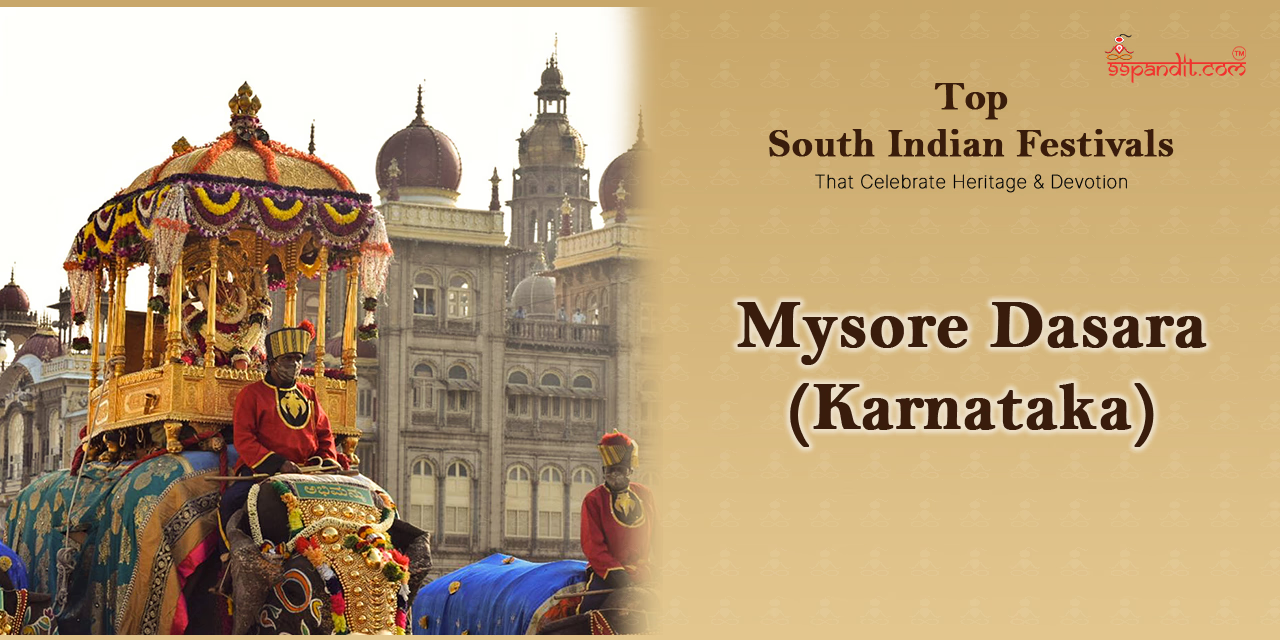
A legend behind celebrating it is that Mother Chamundeshwari killed the demon Mahishasura (Mahishasuran) on the 10th day after the completion of Navratri.
Since then, this day has started being celebrated as Vijayadashami. This festival lasts for 10 days throughout the state.
According to the Hindu calendar, this festival is observed on the tenth day of Ashwin and typically falls sometime in September or October.
Mysore Dasara is performed for ten days in Mysore, Karnataka, and lakhs of tourists flock to enjoy this festival. This Dussehra is called Dasara or Nabababa by the locals.
This festival begins with worship at the Goddess Chamundeshwari temple. The royal family first worships Goddess Chamundeshwari.
During the festival of Dussehra or Vijayadashami, the Raj Darbar of Mysore is opened to the general public, and a grand procession occurs.
In the Mysore Dasara, either Ram or Ravana effigies are not burned. This festival is a celebration of Mother Bhagwati slaying the demon Mahishasura.
Ugadi is the beginning of the new year according to the Telugu calendar. This festival is celebrated with great enthusiasm in its most valid form in Andhra Pradesh, Telangana, and Karnataka.
Ugadi means Yuga Aadi, the beginning of a new yuga and era. This festival occurs in the month of Chaitra.
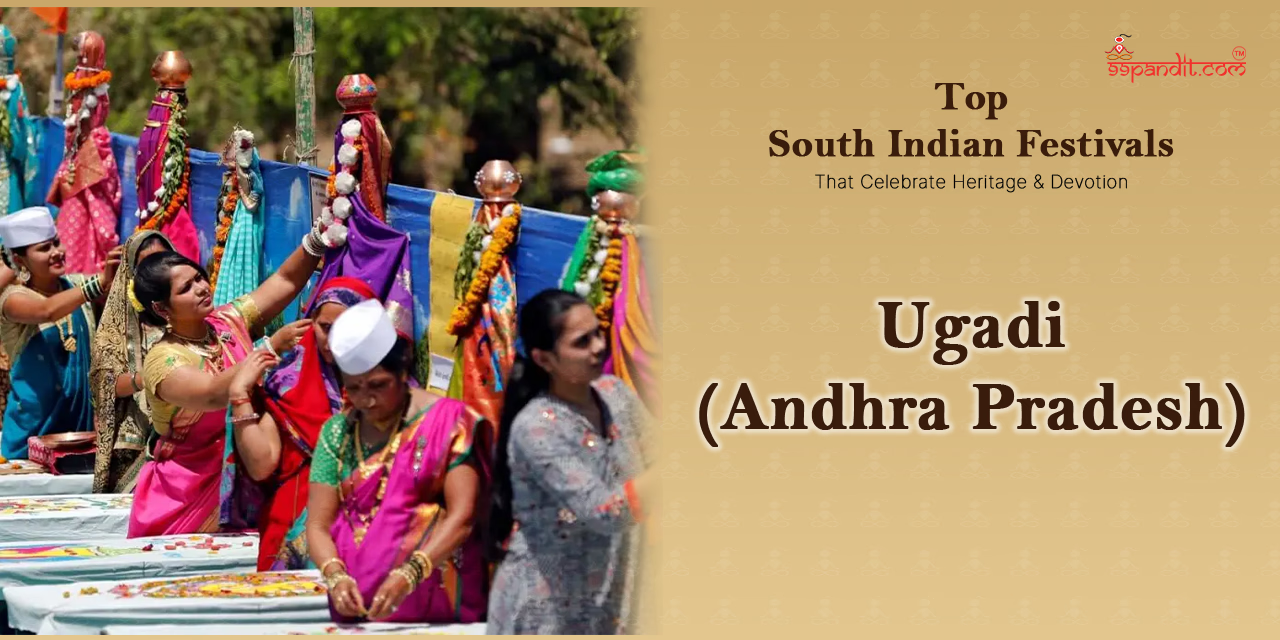
Mythologically, it is believed that Lord Brahma created the heavens and the earth on this day. Thus, this day also has an aspect or symbolism of beginning.
On this date, houses are adorned with mango leaves, special prayers are performed, and new resolutions are undertaken.
Ugadi is one of the most significant Hindu festivals. This festival falls on the Pratipada Tithi of the Chaitra month and signifies the commencement of a new season.
Ugadi is not simply marking the beginning of a new year, but is about new beginnings that introduce spiritual unfoldment, improve the human condition of prosperity, and exhibit a new birth with energy.
Ugadi Pachadi is a special dish made on the occasion of Ugadi. It has six tastes (sweet, sour, bitter, spicy, salty, and astringent).
These six tastes signify the different flavours associated with diverse life experiences and educate us to acknowledge each life experience equally.
Thrissur Pooram is the most celebrated Festival in Kerala. It falls in the Malayalam month of April-May and lasts eight days.
This iconic festival features beautifully decorated elephants, colourful umbrellas, and music. Indeed, Thrissur Pooram adds to the spiritual fabric and culture of Kerala.
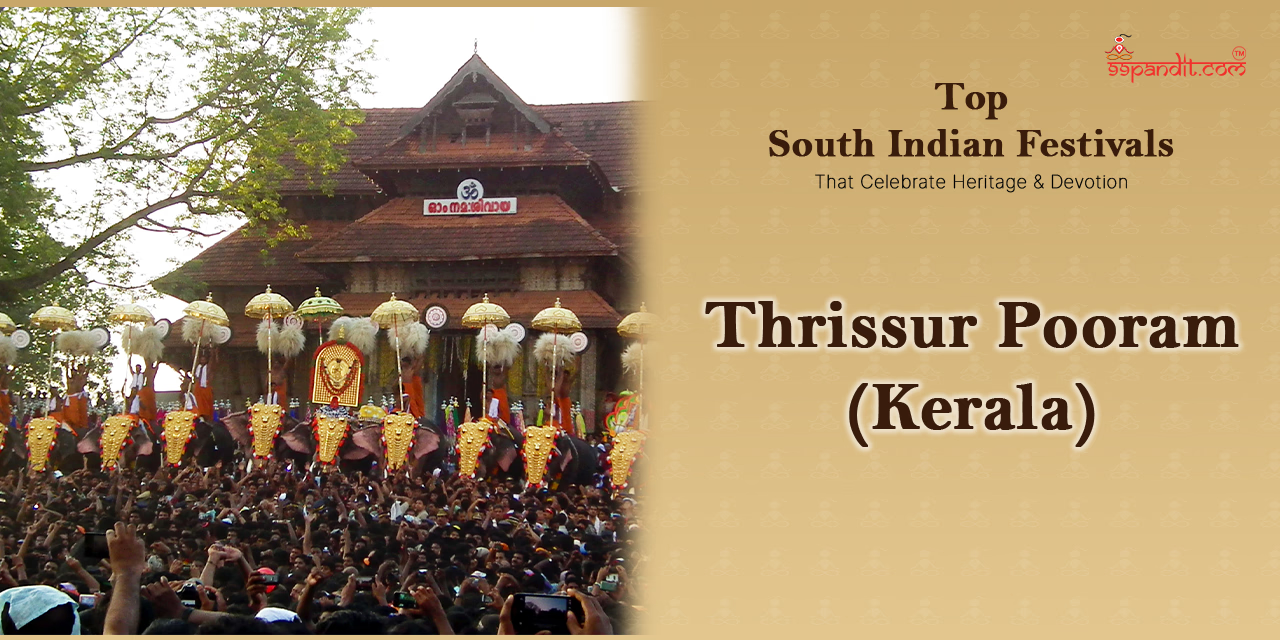
There is a popular legend behind it, which states that when a group of temples was banned from participating in the popular Arattupuzha Pooram due to heavy rains, Shakthan Thampuran decided to start his festival, Thrissur Pooram, after listening to their complaints.
Thrissur Pooram is an important festival that attracts many tourists every year. During this time, grand pujas are performed in all the nearby temples.
In this, more than 50 decorated elephants are taken out on a religious procession, and traditional music is also played. The festival is also famous for its elaborate fireworks display, Vedikettu.
Mahamaham is an important Hindu pilgrimage and bathing festival. This Festival (Kumbh Mela) is held in Kumbakonam, a city in Tamil Nadu.
It is also known as the Kumbh Mela of South India. This Kumbh Mela is held in South India. Its next festival will be held in 2028.
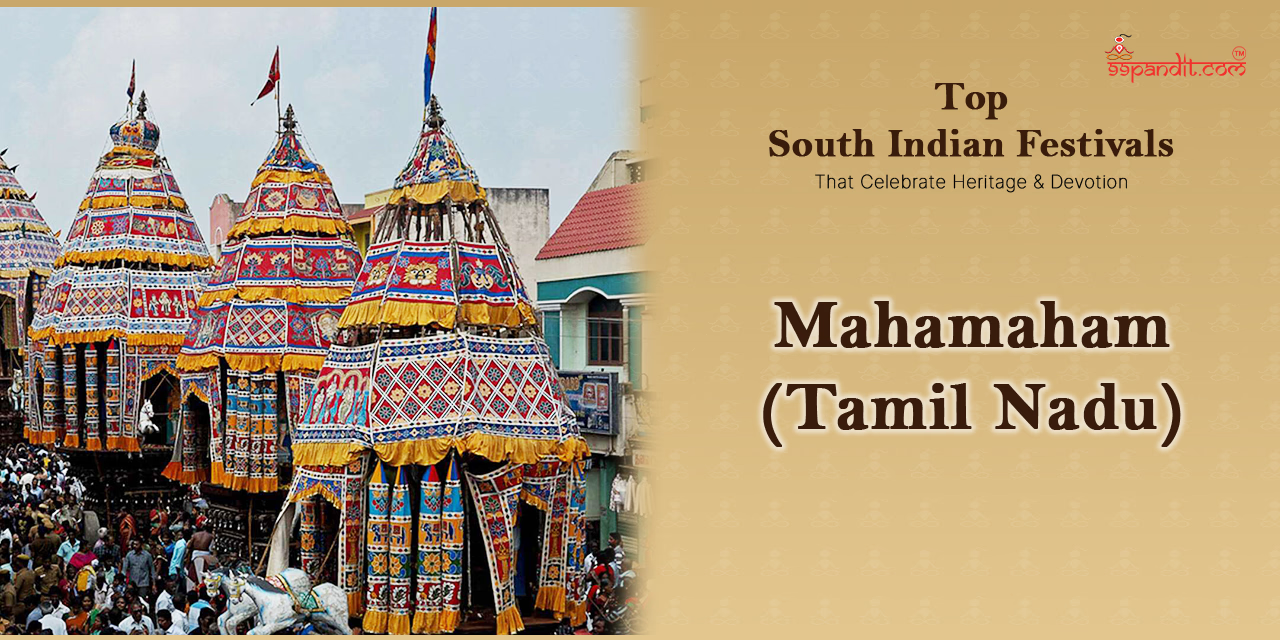
Maha Kumbh Mela is organized every 12 years in Prayagraj, Haridwar, Nashik, Ujjain, and Kumbakonam in Tamil Nadu. Lakhs of devotees attend the fair.
The festival takes place near the Mahamaham tank in Kumbakonam, which is considered a convergence point for all the holy rivers of India during the festival. This fair is also celebrated in the month of Magha (February-March).
The Mahamaham Festival occurs every 12 years, the last One Being celebrated in 2016. Hindus believe that during the festival, all the country’s essential rivers come together in the pond of Kumbakonam.
Therefore, bathing in the pond during this period gives the combined benefits of bathing in all the rivers. The last day of the Mahamaham festival is considered the most special.
Today, the idols of all the deities from the temples in Kumbakonam are bathed in the pond. On this day, millions of Hindus bathe in the pond, which is called Theerthavari.
Bonalu is one of the most popular and widely celebrated festivals in Telangana and Andhra Pradesh. It is celebrated in Asadha and is a month-long festival to thank Goddess Mahakali.
Women across the state wear traditional attire and offer Bonam as an offering to the goddess. Bonam, or meal, consists of cooked rice with jaggery, curd, and water stored in earthen pots.
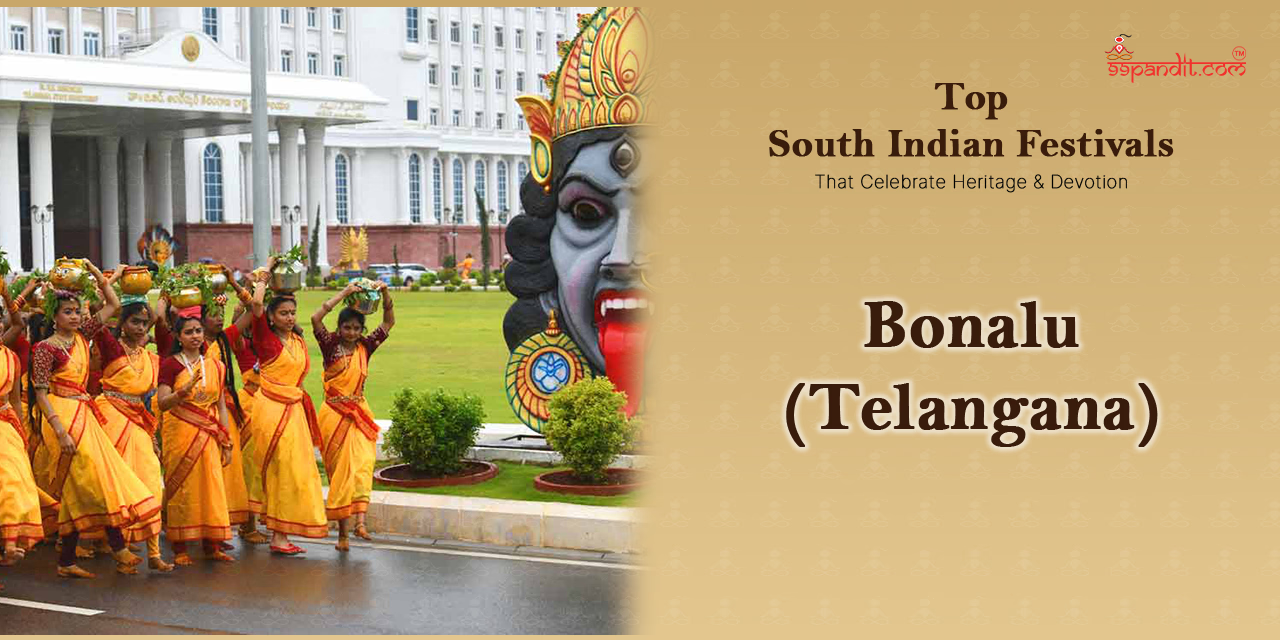
Women carry each pot decorated with flowers on their heads to offer to the goddess. The festival has its origins in the 19th century.
When a battalion of the Hyderabad army prayed to the goddess to end the plague, the plague had ravaged the city, and promised to install an idol of Mahakali in Hyderabad if the goddess did so. It is believed that the goddess ended the plague, and the battalion installed the idol.
This festival has great significance; hence, in 2014, when Telangana was formed, Bonalu was declared a state festival.
The festival starts from the Golkonda Fort. During this festival, women carry the Bonalu and go to the temple.
Women carrying Bonalu are considered the goddess’s spirit, so as they approach the temple, devotees sprinkle water on them to pacify the spirit. Traditional dances like the Potharaju dance are performed in many parts of the state.
The Hampi festival, which is celebrated with great pomp every year, is also known as Hampi Utsav and Vijaya Utsav.
This three-day festival has been celebrated since the era of the Vijayanagara dynasty. During this festival, talented Indian artists give many cultural performances.
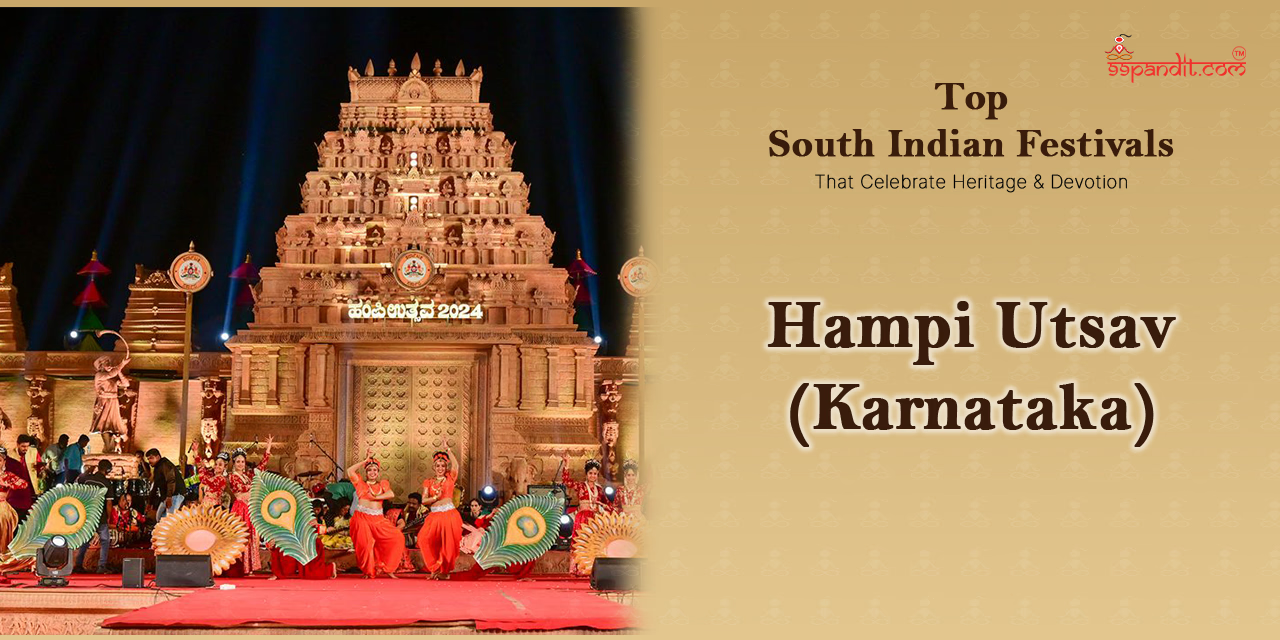
Hampi Festival combines cultural music, art, and dance. Its most special feature is its light and sound show, which uses many special lights. This festival is celebrated with great pomp every November.
Hampi Utsav has its roots in the days of the Vijayanagara Empire. The festival was celebrated when Hampi was the capital of the empire. This festival celebrates the rich heritage of the Vijayanagara Empire.
This festival attracts thousands of tourists from all over the world. Hampi city is known for its historical monuments and temples.
Meenakshi Thirukalyanam is a month-long festival celebrated in the Meenakshi Amman Temple in Madurai, Tamil Nadu. It is also known as Chithirai Thiruvizha or Madurai Meenakshi Amman Thirukalyanam.
The end of the month-long celebration ultimately concludes with a sacred marriage between Lord Shiva and Meenakshi Amman, an incarnation of Goddess Parvati.
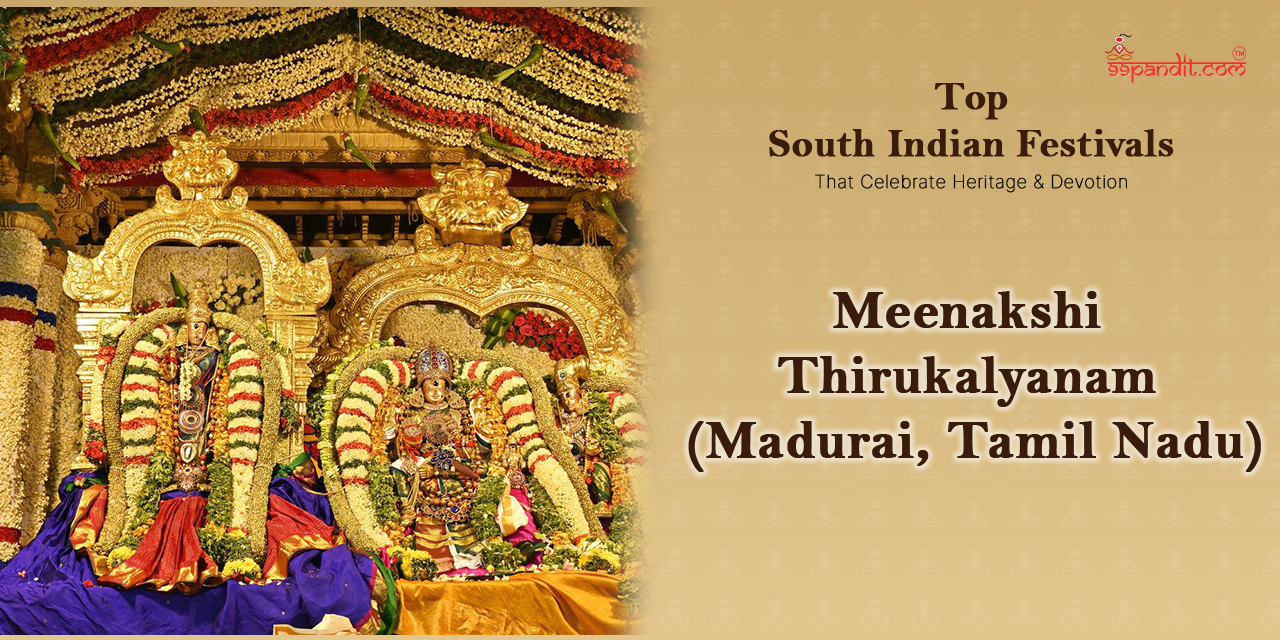
Meenakshi Thirukalyanam is a grand-scale festival that invites pilgrims from every corner of India.
The festival formally begins with a procession where Lord Shiva and Meenakshi Amman will be brought out of the temple and placed in a chariot. This event is a big celebration with music, dance, and decoration.
Meenakshi Thirukalyanam is a significant festival in South India. The festival symbolizes the marriage of Meenakshi Amman with Lord Shiva.
On the wedding day, Lord Shiva and Meenakshi Amman are united in a symbolic ceremony.
The statues of Lord Shiva and Meenakshi Amman are placed on a mandapam, where priests conduct the wedding ceremony.
Devotional songs and hymns are played throughout the event, creating a festive atmosphere.
Karthigai Deepam is one of the significant festivals of South India. It is celebrated in the month of Karthigai according to the South Indian calendar, which is held on the full moon day of the month of Margashirsha according to the North Indian calendar.
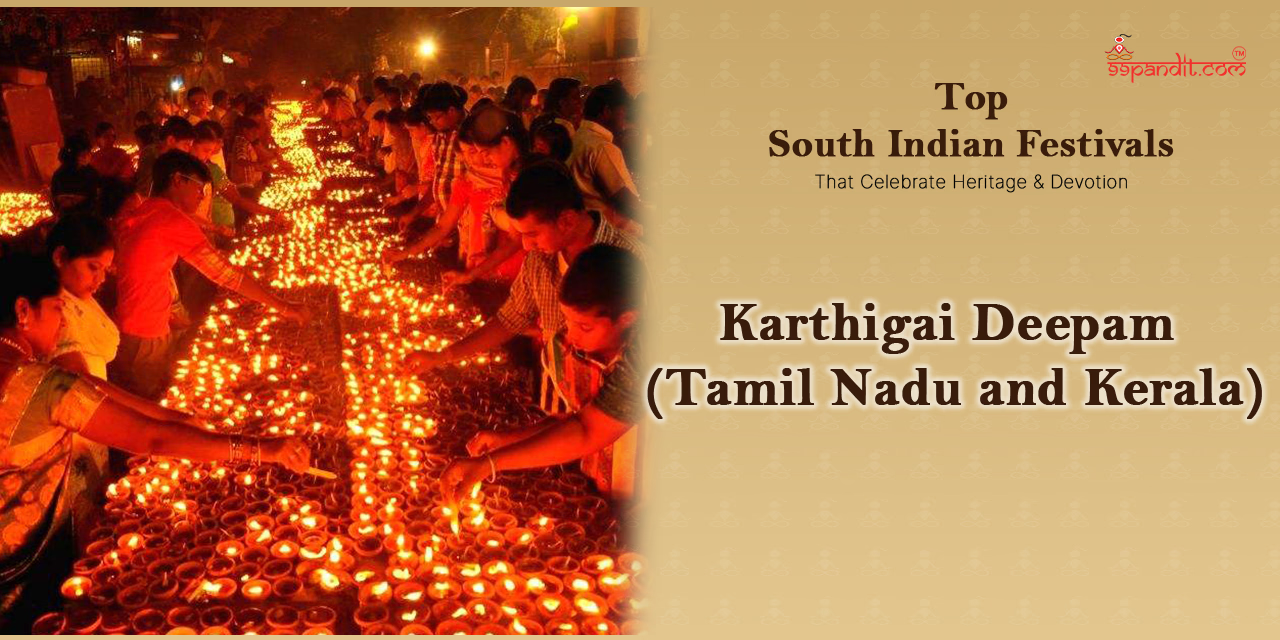
In Tamil Nadu and Kerala, this festival is celebrated like Diwali. Kolam, i.e., Rangoli, is made in every house early in the morning, and people celebrate the festival by lighting earthen lamps in the evening.
Karthigai Deepam festival is considered to be dedicated to Lord Shiva. During this festival, people light lamps in every house to drive away negative energy, i.e., evil power, and invite positive energy, happiness, and prosperity into the house.
Special prayers are organized in all Kerala and Tamil Nadu temples on this occasion. The grand Karthigai Deepam festival is organized in Tiruvannamalai Arunachaleshwar Swamy Temple of Tamil Nadu, famous as Karthikai Brahmotsava.
On this day, millions of devotees gather at the Arunachaleshwar Temple, situated on top of the hill, and huge lamps called Mahadeepam are lit.
These lamps are believed to symbolize Lord Shiva’s light form and are related to the Jyotirlinga of Lord Shiva, which is mentioned in the Shiva Purana.
Festivals in South India are a lively combination of traditions, practices, and celebrations that reflect the region’s cultural heritage.
Events like the festive atmosphere of Mysore Dasara, the joyous commemoration of Ugadi, and the celebration of summer at Pongal are celebrated grandly by thousands.
The Indian Famous Festivals of South India are not just local but celebrated across the country with the same exuberance.
They give you a unique opportunity to experience the cultural diversity that characterizes South India. It is a mix of antiquity and contemporary exuberance.
Each festival represents the spirituality, artistic expression, and sense of community of the region, which therefore becomes a part of India’s culture.
That is it for today. I hope you enjoy reading this article. These famous South Indian Festivals are more of a cultural bonding than just a celebration.
So, when are you planning to visit South India and enjoy these festivals with your friends and family?
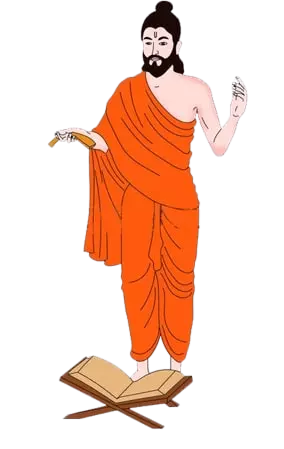
100% FREE CALL TO DECIDE DATE(MUHURAT)

Table Of Content
Filters by categories
All Pujas
Puja On Special Events
Upcoming Pujas
Dosha Nivaran Pujas
Mukti Karmas
Filters by Trending Topics
Filters by Regions
North Indian Pujas
South Indian Pujas